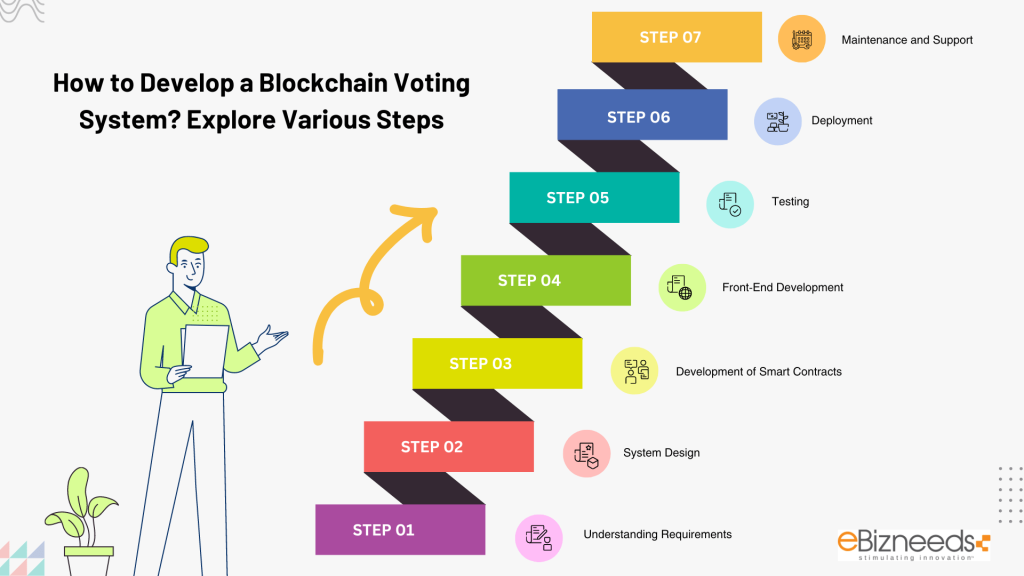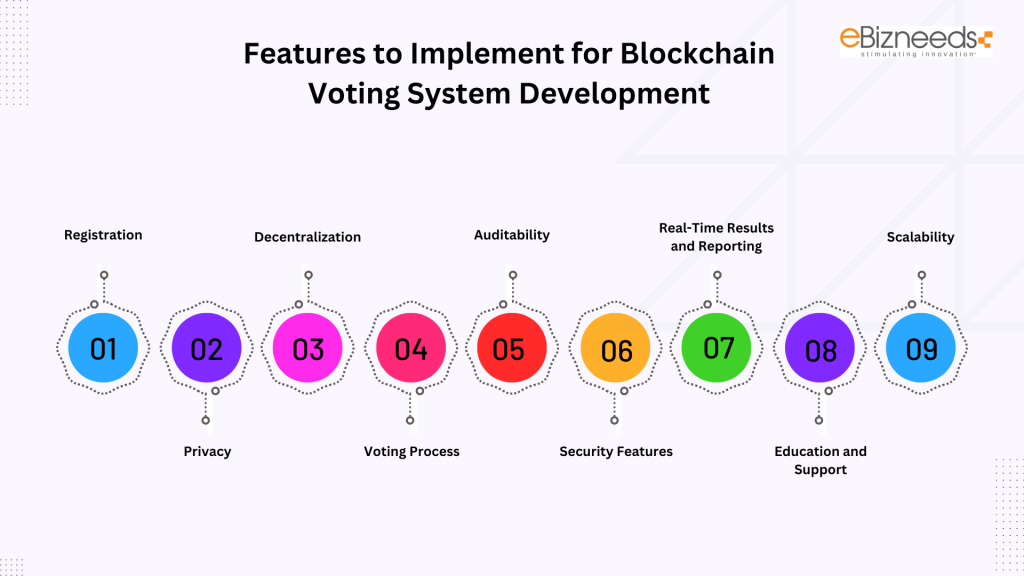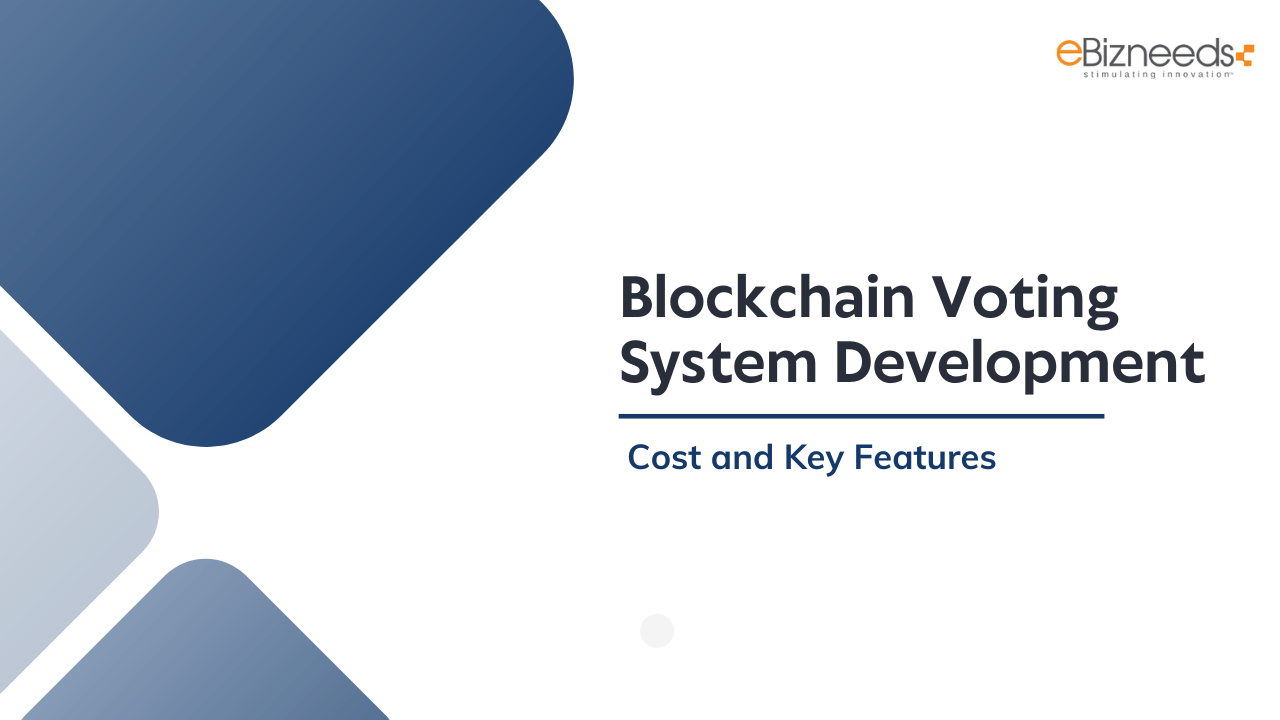Blockchain voting systems have redefined the way voting is conducted and have made the entire process more transparent and efficient. It has replaced the traditional voting system by introducing a secure and reliable voting system. Due to this, the demand for Blockchain voting system development has flourished unprecedentedly. This has also expanded the market size of Blockchain Technology. According to a report, the overall market size of Blockchain technology is likely to climb to $69 billion by 2030.
While developing a Blockchain voting system, several important things need to be considered—features and cost are among them. Features are essential to ensuring the voting system’s success, whereas getting exact details about cost helps you prepare your budget accordingly.
This post lets you delve into the details of the necessary features and costs of Blockchain voting system development. Let’s start.
What is a Blockchain Voting System?
Well, a Blockchain voting system serves as a platform developed by leveraging Blockchain technology. The platform serves its core purpose of conducting secure elections while maintaining full transparency. It averts any possibility of vote alteration or any kind of tempering by recording votes.
Blockchain voting system records votes in a decentralized ledger, ensuring transparency of the entire process and auditability. The system boasts of distributed consensus, encryption, etc., to boost security and avoid any possibility of fraudulent activities.
The Blockchain voting system ensures full anonymity to every voter while maintaining the integrity of election results. The system has tantalized the sense of users for redefining the traditional voting system with improved efficiency and reliability.
How Does Blockchain Voting System Work?
As mentioned, a Blockchain voting system records votes by leveraging decentralized ledger technology while offering security, transparency, and tamper resistance. Every vote that users cast through the system acts as a ‘block’, which is added to the Blockchain.
When users access the system to cast their vote, it’s encrypted and linked to those of previous blocks in the chain. Every node in the network works effectively to check the authenticity and verify votes.
This process is important to ensure that only authentic votes are added to the chain. After the final confirmation, the vote is then recorded permanently and no one can change it.
The credit goes to the decentralized nature of this platform which plays a crucial role in maintaining transparency as participants can see the entire voting process. Voters find it convenient to verify the vote without compromising anonymity.
How to Develop a Blockchain Voting System? Explore Various Steps



Developing a Blockchain voting system is a systematic process that involves numerous steps. All these steps serve some specific purposes. We will take a detailed look at all those steps.
1. Understanding Requirements
The first step of a Blockchain voting system starts with gathering the necessary requirements. During this phase, the development team gathers details about voters, stakeholders, developers, election officials, and more.
Apart from this, they also need to consider various important factors such as user accessibility, voting process, security, and compliance.
2. System Design
Once the development team gathers all the necessary details related to the project, the job of the designer now starts. These professionals are responsible for creating the design of the Blockchain voting system.
Their tasks involve creating architecture by selecting a Blockchain platform. Be it security, scalable, or ease of development, they consider several factors while selecting the platforms. They are also concerned about defining the flow of the data within the system. Designers craft a user interface while ensuring its intuitiveness.
3. Development of Smart Contracts
Smart contracts play a vital role when it comes to automating the process including vote casting and counting. This phase includes mainly two important things such as contract creation and testing.
Developers create smart contracts for handling the registration process, voting, and result matching. Once they develop the contract they check for bugs or any kind of vulnerabilities by conducting rigorous testing under different scenarios.
4. Front-End Development
Front-end development mainly involves creating the user interface and its integration with Blockchain. The team creates a user interface for the voting system by leveraging frameworks including Angular and React.
After completion of the development process, the team connects the front end with Blockchain with the help of APIs. It ensures users can interact seamlessly with smart contacts.
5. Testing
Testing is another crucial phase that involves checking bugs and technical glitches. QA experts conduct a variety of tests to ensure the security and reliability of the system. They conduct functional testing to check whether all functionalities work properly.
Security testing serves its ultimate purpose to check security issues and data protection. The team also conducts user acceptance testing to check the system and get feedback to take necessary measures for improvements.
6. Deployment
Once the team finds no issues with the newly developed voting system, they deploy the system. For the deployment, they first choose a Blockchain system, which could be either private or public.
They make selections based on the project requirements. They implement the system perfectly to implement smart contracts and front-end apps while ensuring every component works properly.
7. Maintenance and Support
Maintenance and support are necessary to ensure smooth function and higher performance of the Blockchain voting system. During this phase, professionals check thoroughly the performance of the system and address issues quickly.
They also implement necessary updates to enhance both security and functionality according to emerging technologies and user feedback. They offer various support channels for users to address various questions and concerns.
Features to Implement for Blockchain Voting System Development



While developing a Blockchain voting system, it’s necessary to implement the right features to make the system purposeful. Following are some of the must-have features for the said system. You can consider implementing them as well.
1. Registration
The voting system should include a registration feature, which ensures only valid and eligible users can access the system. Before accessing the system, users need to first register themselves by providing the required details.
After completing the registration process successfully, users become eligible to participate in the voting process. The system leverages decentralized identity solutions to verify the identity of voters. Blockchain makes it impossible to alter or duplicate the identity of voters.
2. Privacy
The Blockchain voting system should be capable of maintaining the privacy of voters. Blockchain is responsible for securing privacy with the help of zero-knowledge proof, encryption, etc.
Encryption of votes is necessary to ensure confidentiality whereas zero-knowledge proofs are useful to validate the eligibility of voters even without revealing their identity.
The technology boasts cryptographic techniques that ensure the identity of the selection of voters remains anonymous while a recording of the voting takes place.
3. Decentralization
As a core feature of Blockchain technology, decentralization brings a plethora of benefits to the voting system as well – eliminating the necessity of a central authority is one of those.
When it comes to the traditional voting system, it depends on the centralized body to supervise the entire process. That’s the reason why this system is highly vulnerable to fraud or tampering.
As mentioned already, Blockchain voting is decentralized, which reflects that the responsibility for the integrity of the process is distributed across various nodes. Decentralization offers numerous benefits like improving transparency, removing single points of failure, and many more.
4. Voting Process
Make sure your voting system has a highly secured and user-friendly voting process. It encourages users to participate in the voting process. The voting system should allow voters to participate in the voting process from their desired devices. It should be able to ensure both the integrity and accuracy of every vote.
There are several important components of the voting process, including a clear and intuitive user interface, voter authentication, etc. The voting process should be simple, accessible, and trustworthy.
A user-friendly and secure voting process is essential to ensure voter participation and accuracy. The blockchain voting system should enable voters to cast their votes easily from a device of their choice while ensuring the integrity and accuracy of each vote.
5. Auditability
The credit goes to the Blockchain technology that brings the possibility of auditability in the voting systems. When users cast their votes, these are stored as tamper-proof, which ensures easy and also transparent audits.
The distributed ledger of Blockchain ensures every node in the network keeps a similar copy of the voting records, which minimizes any possibility of fraud or alteration.
6. Security Features
No matter what, security is highly important for any voting system. The good thing about Blockchain is it’s available with numerous security features and thus ensures the security of the entire election process.
Blockchain is highly resistant to tampering and fraud since transactions are identified by several nodes and also stored immutably. It includes a large number of security features such as end-to-end encryption, multi-factor authentication, etc.
7. Real-Time Results and Reporting
The Blockchain voting system brings a possibility for real-time results and also reporting even without compromising the integrity of the election. Once the vote is cast and recorded properly, one can tally the results quickly.
It also removes the necessity of the hectic and manual counting processes. By offering real-time results, Blockchain voting systems can certainly minimize the overall time it takes to announce winners.
8. Education and Support
Both administrators and voters need to understand the best use of the platform to make the Blockchain voting system successful. You need to keep in mind that Blockchain technology is complex.
Therefore, it’s quite necessary to offer a proper education and support. The voting should be available with real-time customer support through chatbots, tutorials, guides, simulated voting environments, etc. This feature is essential to ensure participants feel comfortable while casting their votes.
9. Scalability
Scalability is another feature of a Blockchain voting system. It should have enough scalability to handle even large elections where millions of voters participate even without any obstacles. The system should have a proper design for accommodating the highest transaction volumes even without compromising security and speed.
To make the voting system scalable, you can use high-performing Blockchain platforms that can process several transactions every second. You need to also implement layer 2 solutions, dynamic allocation of resources, etc.
How Much Does it Cost to Develop a Blockchain Voting System?
Well, the cost of developing a Blockchain voting system ranges between $150,000 to $800,000. It also depends on many factors such as required features, complexity of the systems, real-time tallying, security measures, voter authentication, and more.



Apart from this, the development time also has a major impact on the overall cost of developing a Blockchain voting system. Ongoing maintenance and support, security compliance, etc., also lets you spend some additional cost.
The experience and expertise of developers also increase the overall cost of the Blockchain voting system. If you hire dedicated developers with less experience they will charge less and vice versa.
Conclusion
So, after going through the above discussion, you now have all the information regarding Blockchain voting system development. The development of this system requires a robust strategy and proven approach to accomplish every step as planned.
Your next step is to hire a Blockchain voting system development partner who can promise you to develop the voting system based on your requirements.
Frequently Asked Questions (FAQs)
Well, the overall time to develop a Blockchain voting system depends on the project’s complexity, specific project requirements, etc. The average time required to develop the said system generally ranges between 4 to 10 months. You can consult us to know the exact time.
Some of the necessary features for a Blockchain voting system include registration, decentralization, scalability, real-time results, education, and support, etc.
We use several technologies to develop a Blockchain voting system. Some of these technologies include Hyperledger Fabric, Ethereum, Corda, and more.
Yes, it’s possible to integrate the Blockchain voting system with the existing system. Meanwhile, you need to plan properly to ensure both systems work properly while maintaining security and accuracy.



Naveen Khanna is the CEO of eBizneeds, a company renowned for its bespoke web and mobile app development. By delivering high-end modern solutions all over the globe, Naveen takes pleasure in sharing his rich experiences and views on emerging technological trends. He has worked in many domains, from education, entertainment, banking, manufacturing, healthcare, and real estate, sharing rich experience in delivering innovative solutions.


